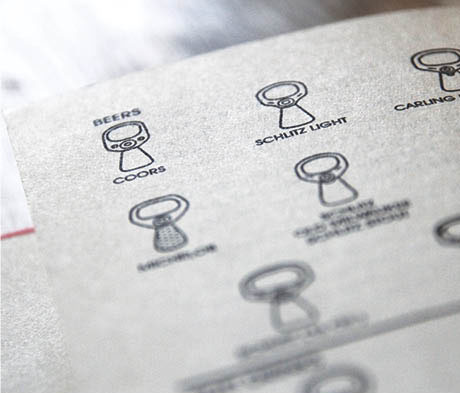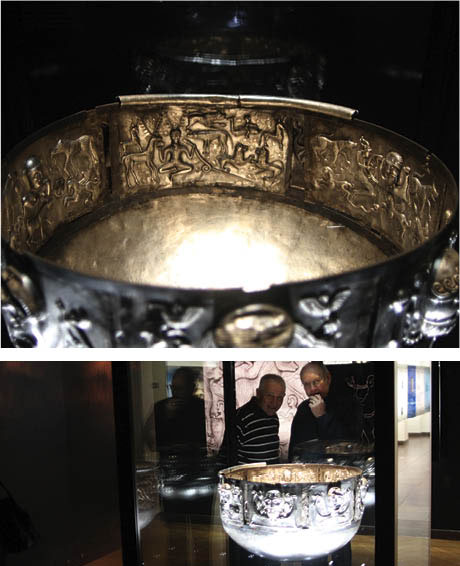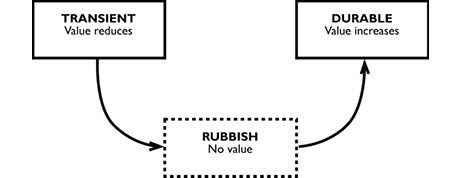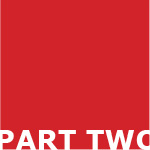Chapter 21:
Object images and material culture – the construction of autenticity and meaning
Objects from daily life can be seen as tokens of culture and society but often they end up as garbage. What decides whether an object stays defined as rubbish or whether it is elevated to the category of valuable object filled with authenticity and meaning? How does this transformation take place and why do the majority of objects remain relegated to the dark shadows of oblivion?
Objects from daily life can tell a story and telling the story contributes to creating meaning. For example, the son of some good friends has a toy spirit stove that can actually be used to cook. The boy’s mother is a petite, talkative redhead. Eagerly engaged in conversation with her daughter one day in the kitchen, her little son, who is playing with the stove, comes running in from his room. He stands patiently and waits, and waits, and waits.
Suddenly his mother jumps up and shouts, “Is that smoke?” She rushes into her son’s room and the curtains are on fire. She quickly puts out the fire, ascertains that there is not much damage and begins wildly shouting at her son: “Why didn’t you say anything?” The boy quietly replied, “Mom, it’s not polite to interrupt”.
The little toy stove in the story is an expression of material culture in 1960’s Denmark, or what I call an object image. I have used this physical object to create a mental image closely linked to this brief story. From a museological perspective, the question must be asked at to whether this toy will ever make it into a museum. If the boy in the story were, say, Frederik, the Crown Prince of Denmark, then it might happen. Otherwise it is not certain that it ever would. How do museums create authenticity and meaning and how do objects become valuable?
Rubbish!
I went to the library to find a book called Rubbish, which I will touch upon later, but discovered another book also called Rubbish! by William Rathje and Cullen Murphy. The latter book was shelved in an entirely different place under redevelopment plans and is my main point of departure for this chapter.
Our private worlds basically consist of two realities, a mental one comprised of our beliefs, attitudes and ideas, and a material one containing physical objects. The book, Rubbish!, is not about waste or Stone Age kitchen middens but today’s waste heaps. The study of human refuse and trash is a field of research known as garbology, which involves collecting, sorting and categorising tonnes upon tonnes of waste. The fundamental dogma of garbology is that what people have owned and thrown away speaks more eloquently, informatively and credibly about the lives they lived than perhaps they themselves could do (Rathje & Murphy 1992:54). Rathje and Murphy explain that much can be read from consumer waste,
You can tell what kind of wine they drink. All their letters come in and out, and who they buy through - Saks or Sears and Roebuck - and how they maintain their household. It’s better’n being a psychiatrist. I can tell you anything you want to know (1992:55).
The assumption that behaviour is reflected in the artefact - or the absence of artefacts - is fundamental to the study of what archaeologists call ‘material culture’. Studying material culture expressed through physical artefacts (from waste in garbage cans to paintings on walls) helps us not only to define a given moment, but also to transform the definition of that moment over time. Microwave dinners and McDonald’s hamburgers reflect not only a new level of diversity in work and family, but they also contribute to that diversity.
Categorisation
In garbology, the sheer quantity and variety of waste involved automatically entails dividing it into multiple categories in order to ascribe significance to the waste. Rathje and Murphy explain that a 044 code, which is for potato peels, means the item can be weighed in bulk instead of counting it (1992:22).

Ill: 21.1: The Garbage Project works with highly detailed categories to sort and weigh garbage to form a factual foundation for the interpretation of findings. Small items like pull tabs can be used to determine what brands and the amount of beverages a household consumes.
When the can disappears and the pull tabs are left
Along the way the Garbage Project encountered what turned out to be a temporary obstacle when beer and soft drink cans began being recycled. Fortunately a clever researcher discovered that while the cans got recycled the little pull tabs were still being thrown in the trash. He subsequently made a typology, or what I call an object image, to categorise which brands households consumed [Ill. 21.1]. Digging through 20 years of waste, garbologists were able to use pull taps to pinpoint the archaeological layers. Coors beer cans, for example had one specific pull tab from March 1974 to June 1977, thus helping to date the various layers.
Results of garbage studies
What are the benefits of doing waste studies? In one projects researchers examined the weekly waste from selected households. They simultaneously asked each household to record all purchases and then compared the waste with the purchases to see if they fit together. This project demonstrated the good provider syndrome, which means that people buy far more than their waste reflects. The amount of purchases presumably shows how well stocked people are with the necessities of life. People generally under-reported the amount of soft drinks, cakes, chocolate and fat they bought and over-reported the amount of fruit and sugar-free soda they bought, to which Rathje and Murphy stated, “It is a sad catalogue of self-delusion”.
Waste and museums
In 1989 the artist Robert Richardson created a Garbage Museum designed to make visitors feel that America was on the verge of being engulfed by garbage. Stacked with waste from floor to ceiling, visitors walked through a well-lit tunnel of jumbled waste. Many visitors undoubtedly equated what they saw with the level of waste in America in general, i.e. an endless number of empty laundry detergent boxes, plastic jugs, Styrofoam cartons, disposable diapers, bottles, cans and fast food packaging. Rathje and Murphy, who believe that this popular perception of waste did not fully correspond with reality, describe what a local waste collector would say if he visited the exhibition and had to evaluate how the waste he handled every day differed Richardson’s construction.
First, there is no dirt mixed in with the waste, which is not the case with genuine everyday waste in a landfill. Nor is there building waste and debris, food waste or garden waste, not to mention soaked newspapers and sludge. Moreover there is much more plastic and considerably less paper at the museum compared to a landfill, where waste is compressed. The absence of both compacted waste and the unmistakable stench of rotting garbage also reflects how the exhibition deviates from reality.
Rathje and Murphy find that a gap exists between the myths about waste and reality and that visitors receive a distorted picture of reality that further validates the misinformation they already possess. Their own misconceptions confirmed, visitors fail to gain new insights and believe what they see, because they are presented with, “... a closed system of fantasy and short-sightedness that both hampers the effective disposal of garbage and leads to exaggerated fears of a garbage crises” (Rathje & Murphy 1992:84).

Ill. 21.3: The famous Gundestrup cauldron a the National Museum of Denmark.
Constructing authenticity
Rathje and Murphy’s implicit and explicit criticism of the Garbage Museum is a matter of authenticity. In order to define what authentic means, it is also important to look at what is not authentic. Housed at the Danish National Museum is the famous Gundestrup cauldron. Found buried in a peat bog near the hamlet of Gundestrup in Northern Jutland, the cauldron is part of the material legacy of Danish prehistory. Indisputably an authentic and valuable artefact from the past, it represents the culture of the 1st century BC. The local museum in Gundestrup has a detailed replica of the cauldron. Traditionally, this copy would not be considered authentic as it was produced in the nineteenth century and not in ancient times. Thus the issue of authenticity is based on the origin of an object and how it was produced.
Rathje and Murphy’s critique of the Garbage Museum does not concern whether the objects are authentic or not or whether the various plastic paraphernalia and glass bottles are dated correctly, but whether the exhibition is an authentically coherent expression of the facts. Their answer is a resounding no. They believe that although authentic items are used, the context is not comprehensive enough; hence visitors experience an inadequate naturalistic representation of reality. Their inventory of what a waste collector would find lacking shows how the context of the exhibition does not present the ‘right’ narrative.
Rathje and Murphy’s scathing criticism derives from their notion of what is authentic, which goes beyond the authenticity of just the objects to encompass the context, the narrative the objects and the texts create, their relationship to one another and the overall coherency of the presentation of the objects and texts. Authentic artefacts can be used to lie, but the truth can also be told with inauthentic objects. For example, the Workers’ Museum in Copenhagen has an installation that shows nineteenth century working class families picnicking in the woods and having a good time. The beer bottles, plates, cutlery, accordion and clothing are perhaps authentic, but the mannequins, like the scenery, have been artificially constructed to appear authentic and to create a specific atmosphere (Floris & Vasström 1999:77). The emphasis is on replicating an authentic contemporary experience in the 1800s via the installation’s design. The criteria for authenticity do not solely revolve around the objects, but the way they must be experienced. In other words, having an authentic experience is as equally important as properly presenting the object with the correct provenience.
The American museologist Lisa C. Roberts believes that there is no need to cherish the objects and that focusing on a realistic experience is the most important goal (1997:99). Robert’s deliberations involve the semiotic landscape and narrative in which significance lies not in the object itself, but in what the external signs add to the object regarding the perception of authenticity and purpose. The visitor can experience the object, but what determines authenticity is not the object itself or the individual visitor; it is also the setting in which the object is placed and which the visitor can experience.
How do visitors experience exhibitions?
Museums are like a picture frozen in time. Objects are placed in a context in a particular room and frozen in a given time. It may be the 1930s or it could be the 1960s. An exhibition can be so deeply frozen that visitors have difficulty thawing it. Or it can be only lightly frozen, allowing visitors to easily thaw it.
Visitors approach an exhibition with what I call an aesthetic gaze and have a wide-ranging aesthetic experience comprised of four elements: values, emotions, knowledge and action. The aesthetic experience goes far beyond the concept of beauty. In order for something to support the aesthetic experience of visitors it must affirm the insights these four fields of experience offer, as well as something that challenges visitors and then adds something new and surprising (Gjedde & Ingemann 2008:115). The four fields of experience can be activated but how they are activated is also highly dependent on the visitors’ goals. The museum has responsibility for planning and activating one or more of the fields of experience.
This construction of experience fields can be practiced more or less adequately and the visitor must be actively open to the exhibition by searching for relations. In a project on democracy (see chapter 9), an informant named Anne walks around with a friend, Rikke, at an exhibition at the Museum of Copenhagen, which focuses on Copenhagen in the 1930s and the 1960s.
Anne creates a number of relationships, but I have chosen to focus on recognition relations, which involve objects that arouse a strong feeling of recognition. Things are nothing in themselves, but when Anne links them to her own personal experiences it also allows her to unpack personal memories and experiences. For example, upon seeing a Nilfisk vacuum cleaner in the display about homes in the 1930s, Anne says, “I remember those. My grandmother and grandfather had one just like it”. Sometimes she also connects sensory experiences to what she recognises. For example, when she picks up a black rotary phone from the 1960s, she exclaims, “Oh, my grandmother and grandfather still have a phone like this. And the receiver is exactly this heavy. It’s a cool receiver to have actually”. She recognises many objects in the part of the exhibition covering the 1960s and 1970s. She has forgotten that some of the objects exist until they catch her eye. For example, when she sees the Karoline cow, she says, “I can remember that. We also had that when I was a kid”.
But recognition is elevated beyond mere registration and is closely tied to personal experiences. She makes the following comment when she sees a penguin moneybox and a bankbook, “Those bank accounts! I remember how proud I was the first time I gave the teller my bankbook”. But there are two items that really ignite her memory. One is a showcase displaying numerous old toys. Whooping with excitement Anne and Rikke exclaim, “No, no I also had ... that lunchbox. You can still get them today”. The other object is Carmen Curlers, which truly brings back memories, “… my mother had some. Do you know how much hair I lost trying to roll those into my hair? It always got so tangled that I nearly lost half my hair trying to cut out the knots”.
The objects works as cues that help Anne talk about what she sees and thus remember experiences and stories from her own life. The entire exhibition is a narrative about past decades, telling visitors much they already know. The various objects, texts, photographs and sounds bring back memories of Anne’s personal story, serving as an opportunity to recall memories, experiences and knowledge from her personal life.
Anne’s aesthetic experience is made up of the four fields of experience but also her own concrete experiences. Going back to the discussion of authenticity, there is the implicit notion that authenticity is linked to what one experiences, i.e. Anne can associate what she sees, hears and feels with her personal life. Consequently she accepts experiences that are good as being authentic and authentic means something she recognises from her own life experiences (see chapter 9).
Construction of value and importance
In the present everything can be collected, recorded and categorised. If you want to preserve the material culture then it is important to find out what values determine whether or not something has meaning. The Garbage Project for example attributes meaning to daily waste, which it records and categorises, but the goal is not to preserve it for posterity or to exhibit it, with the exception of the Garbage Museum. The first library book I was searching for, presents sociocultural theory on how things are ascribed value, or rather that the value assigned to things is a constant, ongoing process.
The sociologist Michael Thompson’s book, Rubbish Theory, identifies two completely different ways of looking at objects, which are one aspect of our perception of our physical and social environment and our worldview. Thompson explains that in our culture, objects are attributed to one of two broad categories. They are either transient or durable (1979:7). Objects in the transient category lose value over time and have a finite lifespan, e.g. as is the case with used cars. As time passes, they become less and less valuable. Objects in the durable category in contrast gain value over time that ideally lasts indefinitely, e.g. as is the case with a Louise Seize chair from the 1700s.
But Thompson does not believe that objects have inherent qualities that determine whether they are transient or durable. Instead, the category they belong to is an expression of one’s worldview, i.e. a social construction. Some people have the power to define objects as durable and other things as transient (Thompson 1979:9).
The paradoxical question must be asked as to how a self-repairing system of this nature can ever transform? Thompson comes to the conclusion that the answer is that the two general categories do not cover the entire universe of objects. There are some objects (with zero or unchanged value), which do not fall into one of these two categories, and they account for a third, hidden category: rubbish [Ill. 21.3].

Ill. 21.3: Michael Thompson rejects the simple dualism between objects of growing value being in the durable category and objects of declining value being in the transient category. As a result he developed a third category, rubbish, where items can remain of no value for years only to be reallocated value by institutions and persons.
His hypothesis is that this hidden rubbish category is not subject to the same verification mechanisms and thus represents an opportunity for transient objects to make the seemingly impossible move to the durable objects category (Thompson 1979:9). He believes that once an object diminishes in value and slides into the category of rubbish, it will not disappear and will not turn into dust. It continues to exist in a timeless and valueless universe waiting for an opportunity to be re-discovered. Thompson presents a specific example of this movement through the three categories.
In 1879, Thomas Stevens manufactured and sold colourful woven silk-pictures depicting e.g. Dick Turin’s ride to York on his good horse Black Bess and the stagecoach between London and York. In 1879 these pictures, known as Stevengraphs, cost a shilling; in 1950 they were impossible to sell; and in 1971 they cost 75 pounds each. What is the explanation behind this change in value? Thompson describes three stages:
1) Original value of one shilling. The object’s value declined over time, thus putting it in the transient category.
2) Long interim period. The object’s value was zero and it did not increase or decrease over time, thus putting it in the rubbish category.
3) In about 1960 Stevengraph’s began gaining value and continue to do so today, thus putting them in the durable category (Thompson 1979:18).
Moving from the category of being rubbish to being permanent took place in 1960, at which point exhibitions were held and articles written about Stevengraphs. When they became a topic for journalists and later scholars, they became visible and consequently gained greater economic value, which also increased their aesthetic value.
Rubbish theory and museum objects
The largest known example of European Iron Age silver work, the Gundestrup cauldron, a unique find decorated with Celtic stories and myths that presumably dates back to the 1st century BC, was in the durable category from the moment it was discovered [1]. But do plastic, glass and packaging from the 1960s have value? It has no economic value. Since the moment they were purchased they were in the transient category and literally landed in the rubbish category with no value when driven away as waste to be dumped in a landfill. However when artist Robert Richardson created the Garbage Museum, these seemingly worthless objects entered the durable category upon being displayed. The musealisation of the objects gives them value, i.e. someone has ascribed them value; thus they become durable.
When an object becomes part of a museum’s collection, removing it again is nearly impossible. The 1960s toy stove described at the beginning of this chapter exists in the thousands, but it generally belongs to the rubbish category and has zero value. The minute the Museum of Copenhagen decides to do an exhibition on the 1960s that has a section on the home, and thus also on children’s toys, then my toy stove (or a similar one) will be allocated value and enter the durable category. As a result, the museum and the exhibition determine which objects are given value.
The toy stove is not just a toy stove but an expression of material culture and thus it is used in this context to tell a story of objects as symbolic expressions of consumer culture, economic growth and abundance - and hence the material progress that has occurred since the 1930s. Museums do not create the economic value, they create the symbolic value.
The gap
Object images reflect how objects are used to represent ideas, stories and myths about the past as they are frozen in the museum’s installation of objects, the context, the text and the staging, all of which to a great extent determine how much meaning and authenticity visitors construct. Objects are the material culture’s mental imagery, visible as images and as unseen entities. In order to allow the visitor to create meaning, it is necessary to create a gap between the object and the visitor, just like the pause the little boy in the introductory story was waiting for.
Note
[1] http://en.wikipedia.org/wiki/Gundestrup_cauldron |



